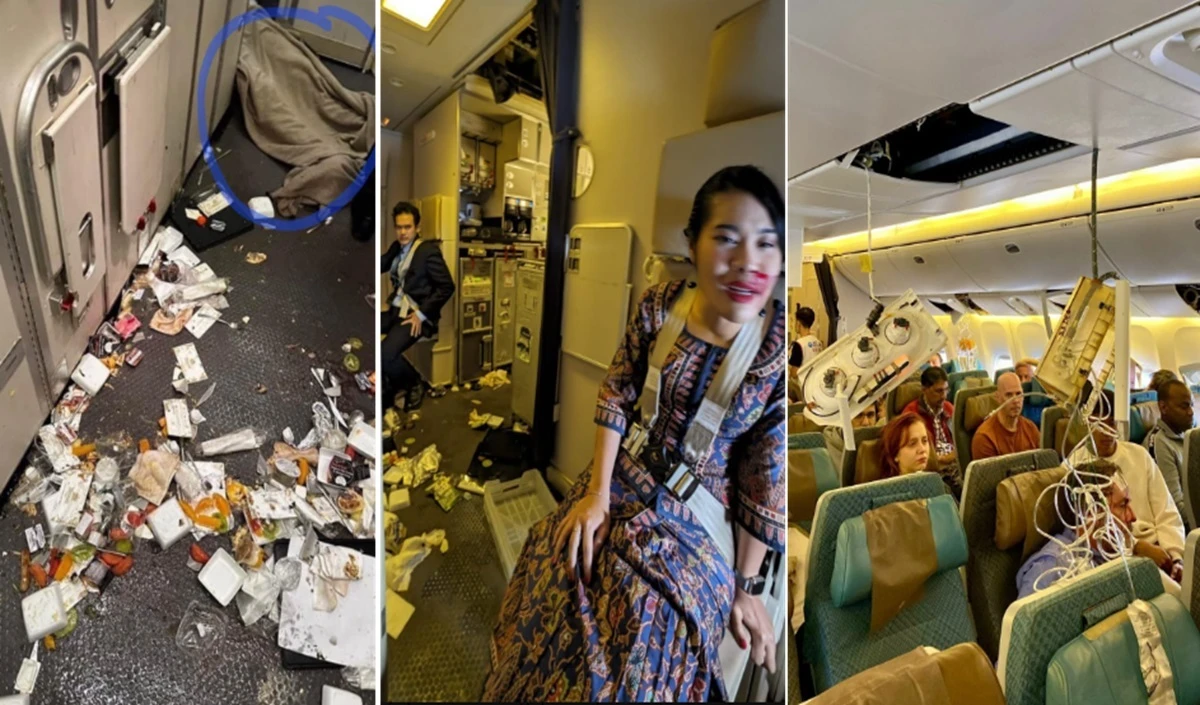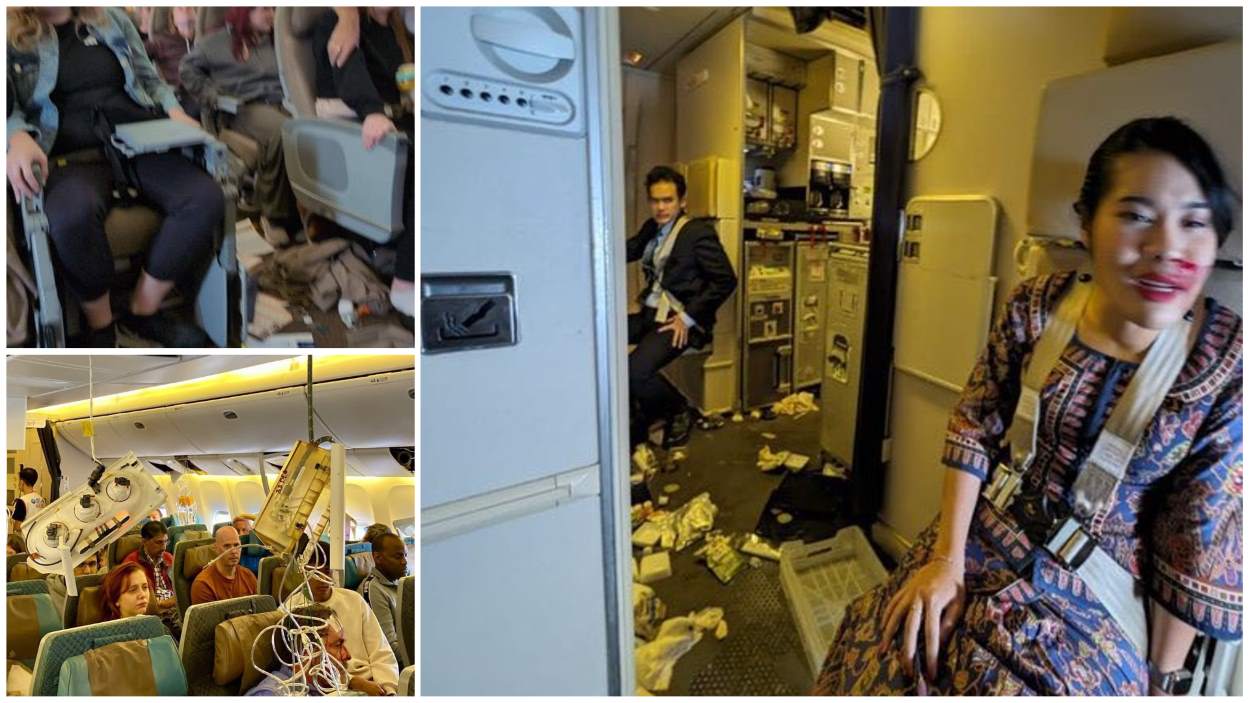Turbulence Incident Overview

Singapore airlines turbulance – On October 27, 2021, Singapore Airlines Flight SQ368, an Airbus A380-800, encountered severe turbulence while en route from Singapore to London Heathrow Airport.
The incident occurred approximately 90 minutes after takeoff, over the Bay of Bengal. The aircraft experienced sudden and violent shaking, causing injuries to several passengers and crew members.
Singapore Airlines has had a bumpy ride lately, with several recent incidents of turbulence causing injuries to passengers. While these incidents are concerning, it’s important to remember that turbulence is a common occurrence in air travel. In fact, a recent tornado in Iowa caused far more damage and injuries than any airline turbulence.
The key to staying safe during turbulence is to follow the instructions of the flight attendants and to wear your seatbelt at all times.
Aircraft and Flight Details
- Aircraft Type: Airbus A380-800
- Flight Number: SQ368
- Route: Singapore (SIN) to London Heathrow (LHR)
- Date of Occurrence: October 27, 2021
Impact of Turbulence, Singapore airlines turbulance
The turbulence caused significant damage to the aircraft’s interior, including cracked ceiling panels, dislodged seats, and damaged overhead bins. Several passengers and crew members sustained injuries, including cuts, bruises, and broken bones.
Singapore Airlines has been in the news recently for its turbulent flights. The airline has experienced a number of incidents in recent months, including a flight that was forced to turn back to Singapore after experiencing severe turbulence. While the airline has a good safety record, these incidents have raised concerns about the safety of its flights.
For more information on Singapore Airlines 321, click here . The airline has said that it is investigating the incidents and has taken steps to improve safety.
The aircraft was forced to make an emergency landing at Kolkata Airport in India, where the injured passengers and crew were taken to local hospitals for medical treatment.
Impact on Passengers and Crew
The sudden and severe turbulence caused significant physical and emotional distress to both passengers and crew members.
Injuries Sustained
The violent shaking of the aircraft resulted in various injuries among passengers and crew. Many sustained bruises, cuts, and sprains from being thrown around the cabin. Some passengers suffered more severe injuries, including broken bones, head trauma, and internal bleeding. Crew members also sustained injuries while assisting passengers and securing loose items.
Psychological Impact and Emotional Distress
The unexpected and frightening nature of the turbulence had a profound psychological impact on those involved. Passengers reported feelings of fear, panic, and helplessness as the plane shook violently. Many experienced flashbacks, nightmares, and anxiety in the aftermath of the incident. Crew members also faced emotional distress, witnessing the injuries and distress of passengers while trying to maintain composure and ensure safety.
Accounts and Testimonials
- “I felt like I was in a washing machine, being tossed and turned violently. I thought I was going to die.” – Passenger
- “I saw people screaming and crying, and I could feel the fear in the air. It was the most terrifying experience of my life.” – Crew Member
- “I’m still having nightmares about the turbulence. I feel anxious every time I think about flying.” – Passenger
Causes and Contributing Factors: Singapore Airlines Turbulance
The severe turbulence encountered by Singapore Airlines flight SQ368 was likely caused by a combination of factors, including:
Weather Conditions
- The flight path passed through an area of thunderstorms, which are known to produce strong updrafts and downdrafts that can cause turbulence.
- The presence of wind shear, a sudden change in wind speed or direction, can also contribute to turbulence.
Aircraft Malfunctions
- Although less likely, a malfunction in the aircraft’s flight control systems or autopilot could have played a role in the incident.
- A sudden change in the aircraft’s weight distribution, such as due to a shift in cargo or passengers, can also affect its stability and contribute to turbulence.
Pilot Training and Experience
- The training and experience of the pilots can significantly influence their ability to handle turbulence effectively.
- Pilots who are well-trained in turbulence management techniques are better equipped to anticipate and respond to sudden changes in flight conditions.
Systemic Issues or Safety Concerns
- The incident raises questions about potential systemic issues or safety concerns within Singapore Airlines or the aviation industry as a whole.
- Thorough investigations will be necessary to determine if any changes to operating procedures, training programs, or aircraft maintenance practices are needed to prevent similar incidents in the future.
Airline Response and Investigation
In the aftermath of the turbulence incident, Singapore Airlines swiftly initiated a comprehensive response and investigation to ensure the safety and well-being of passengers and crew, as well as to determine the underlying causes and contributing factors.
The recent Singapore Airlines turbulence incident is a stark reminder of the unpredictable nature of air travel. While the skies may appear calm and serene, severe weather conditions can develop rapidly, posing a significant risk to aircraft. This is evident in the devastating greenfield tornado today , which caused widespread damage and injuries.
Fortunately, the Singapore Airlines flight managed to land safely, highlighting the importance of pilot training and emergency procedures in ensuring the safety of passengers.
Immediate Actions
- The affected aircraft was immediately grounded for a thorough inspection and maintenance.
- Medical assistance was promptly provided to injured passengers and crew members.
- Passengers were accommodated in nearby hotels and provided with necessary support.
- The airline’s incident management team was activated to coordinate the response and investigation.
Investigation Process
Singapore Airlines collaborated closely with the relevant regulatory authorities, including the Civil Aviation Authority of Singapore (CAAS) and the Air Accident Investigation Bureau (AAIB), to conduct a thorough investigation into the incident.
The turbulence on Singapore Airlines was as intense as the Greenfield, Iowa tornado , with the plane shaking violently and passengers screaming in fear. The tornado had caused widespread damage, and the turbulence was a reminder of the power of nature.
Even though the plane eventually landed safely, the turbulence had left a lasting impression on the passengers, who were grateful to have survived the ordeal.
The investigation involved:
- Examination of the aircraft’s flight data and cockpit voice recorders.
- Interviews with the flight crew, passengers, and ground staff.
- Analysis of weather data and meteorological conditions.
- Review of the airline’s operational procedures and safety protocols.
Findings and Corrective Measures
The investigation identified several contributing factors to the incident, including:
- Unexpected severe turbulence encountered during the flight.
- Challenges in predicting and avoiding the turbulence due to its localized nature.
- Areas for improvement in passenger safety and communication during turbulence.
As a result of the investigation, Singapore Airlines implemented a number of corrective measures, including:
- Enhanced training for pilots on turbulence avoidance and management.
- Improved weather monitoring and forecasting systems.
- Updated passenger safety protocols and communication procedures during turbulence.
These measures were aimed at strengthening the airline’s safety standards and reducing the likelihood of similar incidents in the future.
Safety Measures and Prevention

Singapore Airlines adheres to stringent safety measures to prevent or mitigate turbulence-related incidents, ensuring passenger safety during flights.
The airline utilizes advanced weather forecasting technology to identify and avoid areas with potential turbulence. Weather data is constantly monitored, and pilots receive real-time updates to adjust their flight paths accordingly.
Pilot Training and Protocols
Singapore Airlines pilots undergo comprehensive training programs that include specific modules on turbulence management. They are trained to anticipate, assess, and respond effectively to turbulence during flight.
Established protocols guide pilots’ actions in turbulence. These protocols dictate the appropriate maneuvers and procedures to maintain aircraft stability and passenger safety.
Aircraft Design Innovations
Singapore Airlines invests in aircraft design innovations that enhance passenger safety during turbulence.
Turbulence on Singapore Airlines flights may have subsided, but the threat of severe weather persists. Much like the tornado in Iowa today , unexpected turbulence can strike without warning. However, Singapore Airlines’ commitment to safety remains unwavering, ensuring that passengers can travel with peace of mind, despite the unpredictable nature of the skies.
- Composite Materials: Modern aircraft utilize composite materials that are lighter and more flexible than traditional aluminum alloys. This flexibility allows the aircraft to absorb and dissipate turbulence more effectively, reducing the impact on passengers.
- Active Gust Load Alleviation Systems: These systems use sensors to detect turbulence and adjust the aircraft’s control surfaces in real time. This helps to counteract the effects of turbulence, providing a smoother ride for passengers.
- Turbulence-Tolerant Seats: Singapore Airlines has introduced turbulence-tolerant seats that are designed to minimize passenger discomfort during turbulence. These seats feature advanced cushioning and support systems that absorb vibrations and reduce jolts.
Passenger Compensation and Legal Implications
In the aftermath of the turbulence incident, Singapore Airlines implemented measures to support and compensate affected passengers. Passengers who sustained injuries or lost personal belongings were provided with medical attention, reimbursement for expenses, and assistance with travel arrangements.
Legal Actions and Claims
The turbulence event has prompted legal actions and claims from passengers who suffered injuries or experienced significant distress. Some passengers have filed lawsuits against Singapore Airlines, alleging negligence and seeking compensation for damages.
Impact on Reputation and Public Trust
The turbulence incident has undoubtedly affected Singapore Airlines’ reputation and public trust. The incident has raised concerns about the airline’s safety standards and has led to negative media coverage and public scrutiny. Singapore Airlines has taken steps to address these concerns, including implementing additional safety measures and conducting a thorough investigation.
Lessons Learned and Best Practices
The Singapore Airlines turbulence incident serves as a stark reminder of the importance of aviation safety and the need for continuous improvement in operational procedures. Several key lessons can be drawn from this incident, which can help airlines and regulatory bodies enhance their safety measures and prevent or manage similar incidents in the future.
Best Practices for Airlines
- Enhance pilot training and preparedness: Airlines should invest in comprehensive pilot training programs that emphasize recognizing and responding to turbulence, including advanced weather forecasting and avoidance techniques.
- Improve communication and coordination: Effective communication between pilots, cabin crew, and ground staff is crucial during turbulence. Airlines should establish clear protocols and communication channels to ensure timely and accurate information sharing.
- Implement advanced weather monitoring systems: Real-time weather data and predictive models can provide airlines with valuable insights into potential turbulence areas. Airlines should invest in advanced weather monitoring systems to enhance their situational awareness and decision-making capabilities.
Recommendations for Regulatory Bodies
- Strengthen regulations and standards: Regulatory bodies should review and update regulations to incorporate lessons learned from incidents like the Singapore Airlines turbulence. This includes setting stricter standards for pilot training, weather monitoring, and aircraft maintenance.
- Foster collaboration and information sharing: Regulatory bodies should facilitate collaboration and information sharing among airlines, pilots, and weather experts. This will help identify and disseminate best practices, lessons learned, and emerging risks.
- Promote research and innovation: Regulatory bodies should encourage research and innovation in aviation safety technologies. This includes developing advanced weather forecasting systems, turbulence detection and avoidance systems, and pilot training simulators.
Passenger Safety and Continuous Improvement
Passenger safety remains the paramount concern in aviation. Airlines and regulatory bodies must prioritize passenger safety by implementing robust safety measures, adhering to strict standards, and continuously improving operational procedures. The Singapore Airlines turbulence incident highlights the need for ongoing vigilance, collaboration, and a commitment to continuous improvement in aviation safety.